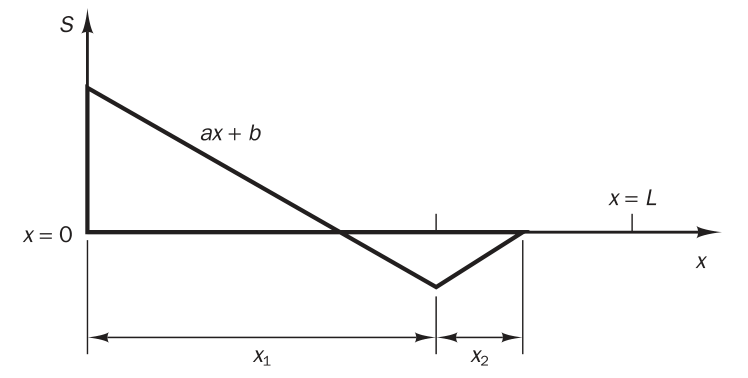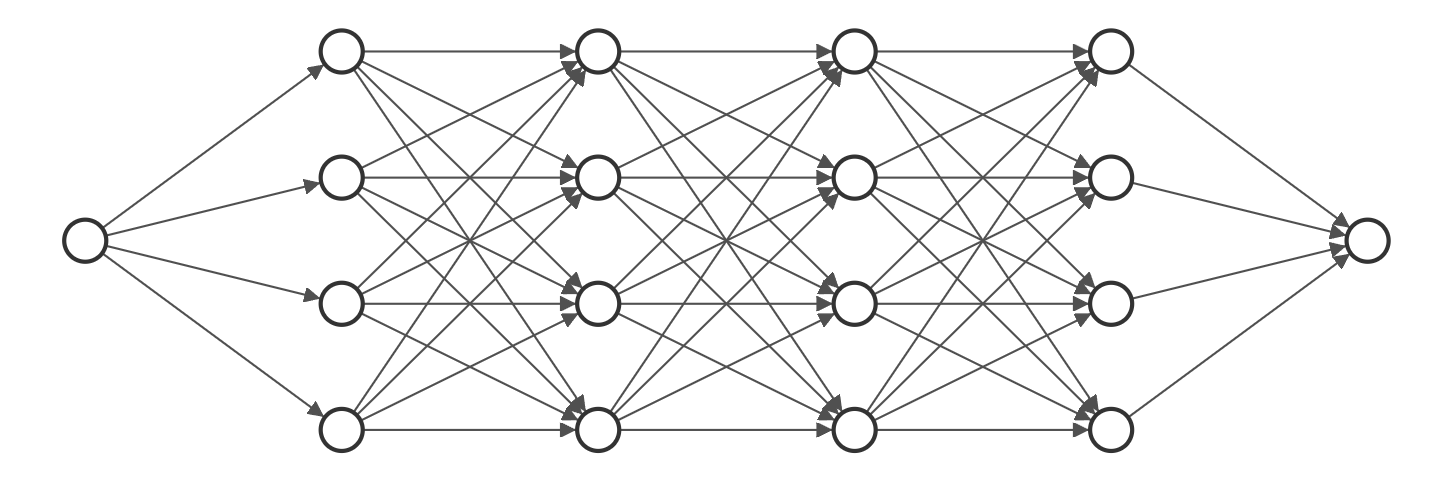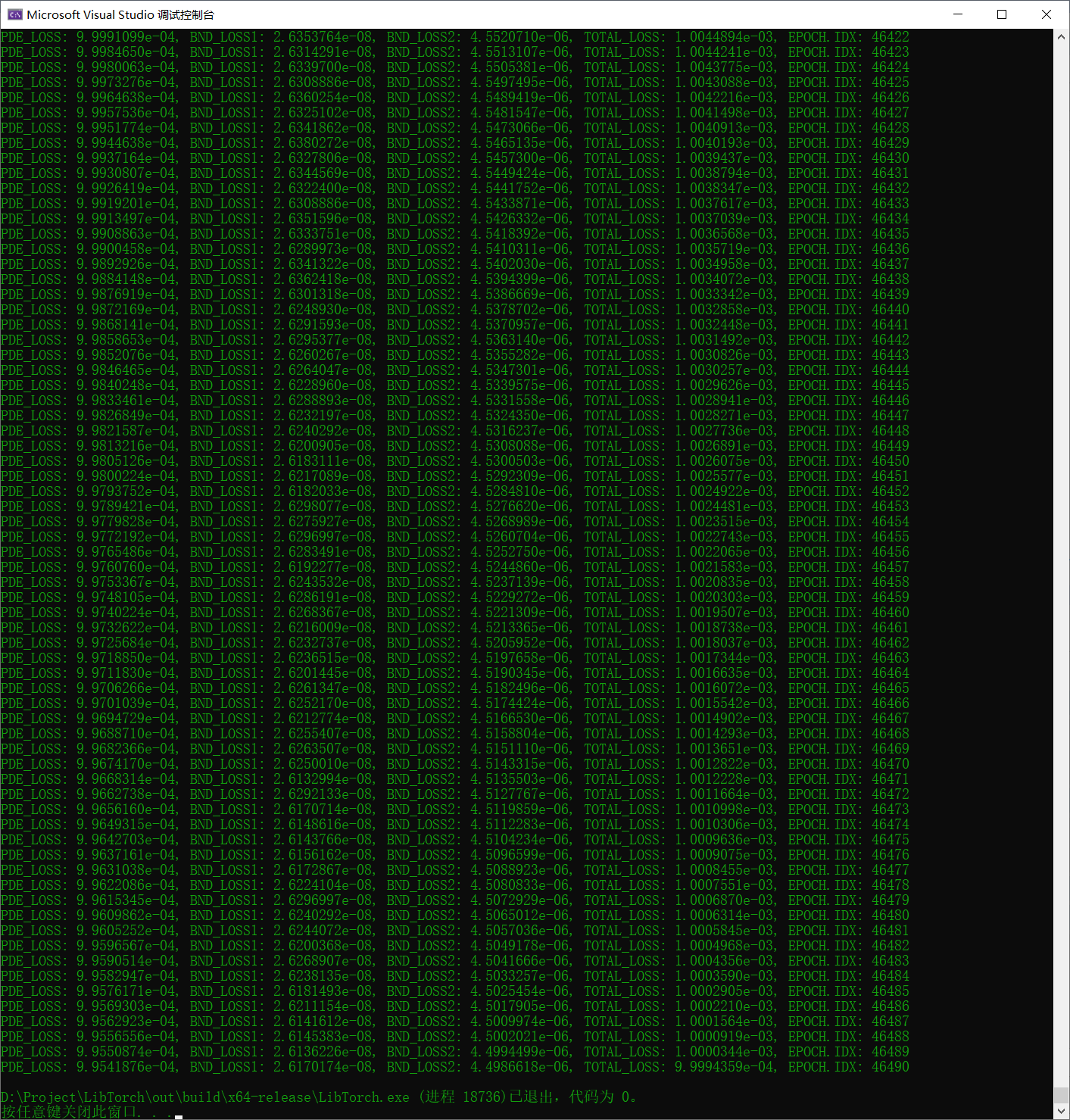LibTorch | 使用神經網路求解一維穩態對流擴散方程
0. 寫在前面
本文將使用基於LibTorch(PyTorch C++介面)的神經網路求解器,對一維穩態對流擴散方程進行求解。研究問題參考自教科書\(^{[1]}\)範例 8.3。
1. 問題描述
一維穩態對流擴散方程為
其中,均勻恆定速度 \(u=2.0 \mathrm{m/s}\) ,運動粘性係數 \(\Gamma = 0.03 \mathrm{m^2/s}\) ,源項 \(S\) 的形式後文將敘述。
假設一維計算域長度為 \(L=1.5 \mathrm{m}\),其上分佈有均勻恆定速度場;待求物理量為 \(\phi\),邊界條件為左側(\(x=0\))處給定一類邊界條件(\(\phi=0\)),右側(\(x=L\))處給定二類邊界條件(\(\phi_{,x}=0\))。如下圖(圖片來自教科書\(^{[1]}\),圖8.7)所示。

在計算域上源項分佈如下圖(圖片來自教科書\(^{[1]}\),圖8.8)所示:

其中,\(a=-200\),\(b=100\),\(x_1=0.6\),\(x_2=0.2\)。
源項數學表示式如式(1)所示。
3. 解析解
上述一維穩態對流擴散方程存在解析解(參考文獻中公式直接計算數值不對,這裡做了一些修改,如果錯了還請讀者斧正):
其中,
使用下面程式碼繪製解析解曲線。
import math
import matplotlib.pyplot as plt
a = -200.0 # [1/m]
b = 100.0 # [1]
L = 1.5 # [m]
x_1 = 0.6 # [m]
x_2 = 0.2 # [m]
u = 2.0 # [m/s]
Gamma = 0.03 # [m^2/s]
P = u / Gamma # [1/m]
P2 = P * P # [1/m^2]
expPL = math.exp( P * L )
num_terms = 20000
def a_n(n):
if n == 0 :
return ( ( x_1 + x_2 ) * ( a * x_1 + b ) + b * x_1 ) / ( 2.0 * L )
else:
alpha = n * math.pi / L
term0 = 2.0 * L / n / n / math.pi / math.pi
term1 = ( a * ( x_1 + x_2 ) + b ) / x_2 * math.cos( alpha * x_1 )
term2 = a + ( a * x_1 + b ) / x_2 * math.cos( alpha * ( x_1 + x_2 ) )
return term0 * ( term1 - term2 )
def C2():
term0 = a_n(0) / P2 / expPL
term1 = 0.0
for i in range(1,num_terms + 1):
alpha = i * math.pi / L
coeff = ( P2 + alpha * alpha )
term1 += a_n(i) / expPL * math.cos( i * math.pi ) / coeff
return term0 + term1
def C1():
term0 = C2()
term1 = a_n(0) / P2
term2 = 0.0
for i in range(1,num_terms + 1):
alpha = i * math.pi / L
coeff = ( P2 + alpha * alpha )
term2 += a_n(i) / coeff
return -term0 + term1 + term2
def phi(x):
term0 = C1()
term1 = C2() * math.exp( P * x )
term2 = a_n(0) / P2 * ( P * x + 1.0 )
term3 = 0.0
for i in range(1,num_terms + 1):
alpha = i * math.pi / L
coeff = ( P2 + alpha * alpha )
term3 += a_n(i) / alpha * ( P * math.sin( alpha * x ) + alpha * math.cos( alpha * x ) ) / coeff
return term0 + term1 - term2 - term3
x = []
y = []
num_points = 50
for i in range(num_points):
x_ = L / ( num_points - 1 ) * i
x.append( x_ )
y.append( -phi(x_) * 0.75 * b / L / L ) # 這裡對參考文獻中的公式做了修改
plt.grid()
plt.xlim( 0, 1.5 )
plt.ylim( 0, 12 )
plt.plot( x, y )
plt.show()
影象如下所示:

4. 神經網路
上述流暢處於穩態時,物理量 \(\phi\) 是位置 \(x\) 的函數,即 \(\phi=f(x)\)。那麼我們這裡的想法就是利用神經網路來表示這個函數,並通過利用機器學習方法(監督學習、自動微分)使該函數滿足控制方程和邊界條件。
對於上述關係,我們可以涉及類似下圖中這種全連線神經網路(使用NN-SVG繪製)。

4.1 網路結構
這裡我們設定了一個含有6層神經元的全連線神經網路,形式如上圖所示,輸入層和輸出層均只有一個神經元,剩餘4個隱藏層每層含有256個神經元。
神經網路類的宣告如下,儲存在檔案 nets.hpp 檔案中,其中需要宣告向前傳播演演算法方法以及相關模組變數。
#ifndef NETS_HPP
#define NETS_HPP
#include <torch\torch.h>
// 神經網路類
class Net : public torch::nn::Module {
public:
Net(const int inDim, const int outDim);
torch::Tensor forward(at::Tensor x);
private:
torch::nn::Linear input{nullptr};
torch::nn::Linear hidden0{nullptr};
torch::nn::Linear hidden1{nullptr};
torch::nn::Linear hidden2{nullptr};
torch::nn::Linear output{nullptr};
};
#endif // NETS_HPP
接下來看一下神經網路的實現,我們將其實現儲存在 nets.cpp 檔案中,其中建構函式中將初始化這些模組變數;forward 方法為向前傳播的實現,資料傳播過程為 \(1\to 256\to 256\to 256\to 256\to 1\),網路接受一個標量輸入並最終返回一個標量輸出;另外隱藏層全部採用 tanh 函數作為啟用函數。
#include "nets.hpp"
Net::Net(const int inDim, const int outDim) {
input = register_module("input", torch::nn::Linear(inDim, 256));
hidden0 = register_module("hidden0", torch::nn::Linear(256, 256));
hidden1 = register_module("hidden1", torch::nn::Linear(256, 256));
hidden2 = register_module("hidden2", torch::nn::Linear(256, 256));
output = register_module("output", torch::nn::Linear(256, outDim));
}
torch::Tensor Net::forward(at::Tensor x) {
// 輸入層 : 1 --> 隱藏層 0 : 256
torch::Tensor phi = input->forward(x);
phi = torch::tanh(phi); // 啟用函數
// 隱藏層 0 : 256 --> 隱藏層 1 : 256
phi = hidden0->forward(phi);
phi = torch::tanh(phi); // 啟用函數
// 隱藏層 1 : 256 --> 隱藏層 2 : 256
phi = hidden1->forward(phi);
phi = torch::tanh(phi); // 啟用函數
// 隱藏層 2 : 256 --> 隱藏層 3 : 256
phi = hidden2->forward(phi);
phi = torch::tanh(phi); // 啟用函數
// 隱藏層 3 : 256 --> 輸出層 : 1
phi = output->forward(phi);
//
return phi;
}
4.2 源項程式碼
分佈源項為分段函數,這塊比較簡單,直接給出標頭檔案和實現。
函數宣告儲存在 utils.hpp 檔案中。
#ifndef UTILS_HPP
#define UTILS_HPP
float Source(const float x);
#endif // UTILS_HPP
函數實現儲存在 utils.cpp 檔案中。
#include "utils.hpp"
float Source(const float x) {
if (x < 0.6) {
return -200.0 * x + 100.0;
} else if (x > 0.8) {
return 0.0;
} else {
return 100.0 * x - 80.0;
}
}
4.3 訓練程式碼
這裡,我們將訓練程式碼儲存在 main.cpp 檔案中。由於空間位置不變,我們在迭代訓練外構造輸入引數。
程式碼實現如下所示,其中計算PDE的損失時用到了自動微分,可參考筆者之前的隨筆LibTorch 自動微分。
#include <fstream>
#include <iomanip>
#include <iostream>
#include <string>
#include "nets.hpp"
#include "utils.hpp"
int main(int argc, char *atgv[]) {
std::cout << std::scientific << std::setprecision(7);
const double L = 1.5; // 計算域長度
const int numElement = 20; // 輸入點個數
// 構造輸入,維度為[N,1],N行,每行為一個輸入,維度為1
std::vector<float> x;
for (int i = 0; i < numElement; ++i) {
x.push_back(L / double(numElement - 1) * double(i));
}
torch::Tensor xT = torch::from_blob(x.data(), {numElement, 1}, torch::kFloat)
.requires_grad_(true);
// 初始化神經網路和隨機梯度下降優化器
std::shared_ptr<Net> net = std::make_shared<Net>(1, 1);
std::shared_ptr<torch::optim::SGD> optimizer =
std::make_shared<torch::optim::SGD>(net->parameters(), 1.e-4);
// 開始迭代訓練
double lossVal = 10;
int epochIdx = 0;
std::vector<float> sol(numElement);
while (lossVal > 1.e-3) {
// 向前傳播,最終輸出是一個[N,1]的輸出
torch::Tensor out = net->forward(xT);
// 構造損失函數(由3部分組成,PDE和兩側邊界條件)
auto ones = torch::ones_like(out);
torch::Tensor ddx =
torch::autograd::grad({out}, {xT}, {ones}, true, true, false)[0];
torch::Tensor d2dx2 =
torch::autograd::grad({ddx}, {xT}, {ones}, true, true, false)[0];
auto sourceTerm = torch::zeros_like(out);
for (int i = 0; i < numElement; ++i) {
sourceTerm[i][0] = Source(xT[i][0].item<float>());
}
auto pde = 2.0 * ddx - 0.03 * d2dx2;
auto pdeLoss = torch::mse_loss(pde, sourceTerm); // 偏微分方程
auto tag1 = torch::zeros_like(out);
for (int i = 0; i < numElement; ++i) {
if (i == 0) {
tag1[i][0] = 0.0;
} else {
tag1[i][0] = out[i][0].item<float>();
}
}
auto bndLoss1 = torch::mse_loss(out, tag1); // 左側邊界條件
auto tag2 = torch::zeros_like(ddx);
for (int i = 0; i < numElement; ++i) {
if (i == numElement - 1) {
tag2[i][0] = 0.0;
} else {
tag2[i][0] = ddx[i][0].item<float>();
}
}
auto bndLoss2 = torch::mse_loss(ddx, tag2); // 右側邊界條件
auto totalLoss = pdeLoss + bndLoss1 + bndLoss2;
// 反向傳播
optimizer->zero_grad();
totalLoss.backward();
optimizer->step();
// 列印紀錄檔
lossVal = totalLoss.item<float>();
std::cout << "PDE_LOSS: " << pdeLoss.item<float>()
<< ", BND_LOSS1: " << bndLoss1.item<float>()
<< ", BND_LOSS2: " << bndLoss2.item<float>()
<< ", TOTAL_LOSS: " << lossVal << ", EPOCH.IDX: " << epochIdx
<< std::endl;
epochIdx += 1;
for (int i = 0; i < numElement; ++i) {
sol[i] = out[i][0].item<float>();
}
}
// 儲存結果
std::ofstream os;
os.open("solution.txt", std::ios::out);
for (int i = 0; i < numElement; ++i) {
os << x[i] << " " << sol[i] << std::endl;
}
os.close();
return 0;
}
4.4 CMakeLists.txt
這裡使用 CMake 管理程式程式碼,內容如下所示。
cmake_minimum_required( VERSION 3.8 )
project( LibTorch)
set( CMAKE_CXX_STANDARD 14 )
set( INSTALL_PREFIX "D:/SoftwarePackage" )
## LibTorch
find_package(Torch REQUIRED PATHS "${INSTALL_PREFIX}/libtorch/share/cmake/Torch")
link_directories( "${INSTALL_PREFIX}/libtorch/lib" )
# My own code
include_directories( . )
set(SRCS
nets.cpp
utils.cpp
)
set(CMAKE_CXX_FLAGS "${CMAKE_CXX_FLAGS} ${TORCH_CXX_FLAGS}" )
add_executable ( ${PROJECT_NAME} main.cpp ${SRCS} )
target_link_libraries(${PROJECT_NAME} ${TORCH_LIBRARIES} )
5. 結果處理
神經網路訓練了近4萬6千多次才滿足收斂標準,其實還是挺慢的。其中誤差最主要來自於神經網路無法滿足偏微分方程(PDE),這和很多因素有關,比如網路結構,收斂判據等。

從下圖數值結果來看,訓練的神經網路給出的結果與解析解能夠較好吻合,後段有一個明顯的誤差,但是相對較小,這個誤差應該來自網路本身,網路結構簡單,改進空間應該還是比較大。

本文寫的比較簡單,也沒有使用批訓練。此外,感興趣的小夥伴可以嘗試使用OpenFOAM求解,可參考筆者之前的隨筆 OpenFOAM 程式設計 | One-Dimensional Transient Heat Conduction 。
參考文獻
[1] H. Versteeg , W. Malalasekera. Introduction to Computational Fluid Dynamics, An: The Finite Volume Method 2nd Edition[M]. Pearson. 2007.
本文來自部落格園,作者:Fitanium,轉載請註明原文連結:https://www.cnblogs.com/Fitanium/p/16678359.html